The NRPC Brownfields Program works with a wide variety of partners to encourage reuse and development of properties with perceived or actual contamination issues. Our program is focused on results that benefit the communities of Franklin and Grand Isle Counties, VT.
NRPC Brownfields Success Stories
Old Hotel Restored for Mixed Use Development
St. Albans House is an important historic a four-story former hotel on Lake St. in downtown St. Albans. The building was purchased and redeveloped by local developer Jim Cameron, with financial support from the City of St. Albans, the Preservation Trust of Vermont, and NRPC in the form of Brownfields Assessment funds.
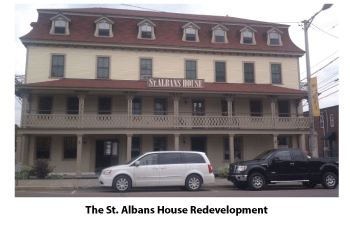 In addition to a hotel, the site was home to a variety of commercial and residential uses since the early 1900s, including auto sales and service and a printing shop. NRPC conducted just under $90,000 in environmental assessments at the site, which confirmed that no remedial actions were required. This allowed the developer to move forward with the rehabilitation into residential apartments on the third and fourth floors and commercial office space on the first and second floors. The redevelopment will be a great asset for downtown St. Albans adding a beautiful façade, unique commercial space and high-quality apartments.
In addition to a hotel, the site was home to a variety of commercial and residential uses since the early 1900s, including auto sales and service and a printing shop. NRPC conducted just under $90,000 in environmental assessments at the site, which confirmed that no remedial actions were required. This allowed the developer to move forward with the rehabilitation into residential apartments on the third and fourth floors and commercial office space on the first and second floors. The redevelopment will be a great asset for downtown St. Albans adding a beautiful façade, unique commercial space and high-quality apartments.
St. Albans Core Redevelopment
The St. Albans Core Redevelopment consists of a parking garage, state office building and hotel to buttress the revitalization of St. Albans City. The parking garage is built on the city’s existing 100-space downtown parking lot. The garage would house a total of 370 parking spaces, 170 of which would be reserved for state employees.
The offices of several different agencies employing nearly 140 people relocated from Houghton Street to a new Federal Street facility, bordering the new parking garage in the center of the City’s downtown.
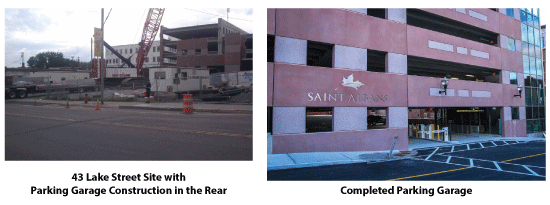
43 Lake Street is the site of the former Loyal Order of the Moose Lodge. St. Albans City currently owns the site, which is adjacent to their City Center Project that includes a new State Office Building and a Parking Garage. The City plans to develop a hotel on the property. This grant partially funded a Supplemental Phase 2 Assessment looking at vapor intrusion potential. The assessment is currently ongoing using other NRPC Brownfield Assessment funding.
111, 113 Main Street, Richford
The 111, 113 Main Street property (.42 acres) is owned by the Richford Economic Advancement Corporation. 111 Main Street was home to a variety of uses, including a millinery, photographer, auto parts retailer, and auto garage, but currently possesses only the foundation of the former building. Uses at 113 Main Street included a barber shop, cobbler shop, small engine repair shop, and it has rail spurs in the rear of the property. The building at 113 Main was recently demolished using NRPC Revolving Loan Fund cleanup grant funding and it also now possesses only the foundation of the former building. This grant funded environmental assessments at the site. The investigations found lead based paint and asbestos containing materials in the building on 113 (now demolished) and shallow soil contamination across the site with a variety of metals and SVOCs. NRPC is currently funding a corrective action plan for the remaining issues at the site. The redevelopment plan is an overlook and public access to a future riverfront park.
Factory Turned Affordable Housing - Leader Evaporator
At 2½-acres, the former Leader Evaporator property has played an integral role in the development history of downtown St. Albans. For more than 100 years, the site has hosted a variety of industrial and commercial uses, including woodworking, fuel oil storage and sales, clothing manufacturing, and most recently, manufacturing of maple syrup equipment – all within an urban residential neighborhood. When Leader Evaporator needed to expand its facility, the downtown site was too small to accommodate its growth. However, its historic structure, complete with elevator and parking proved to be a perfect location for housing.
Working with the site owner and the prospective developers, the Regional Commission invested nearly $83,722 of its grant funds to investigate the site and develop a plan for addressing soils contaminated by lead-based paint and soil and groundwater contamination from a former fuel oil dealer. The contamination at the site was relatively low-level, but protecting the safety of construction workers and the people who would live there was a primary concern of developers. Kathy Beyer, Project Developer for Housing Vermont, said “The Regional Commission’s consultant met with us as often as we needed to discuss options and costs for addressing the environmental issues.” Housing Vermont bought the property in April 2006. Ownership was transferred to the Champlain Housing Trust in September 2006. The Trust invested $6.7 million for remediation and construction activities and developed 24 units of rental housing; deed restrictions will guarantee that 20 of these units will be perpetually affordable. Remediation work was funded through a $92,000 grant from the Vermont Community Development Block Grant program. Redevelopment funding included $505,000 from the Vermont Community Development Block Grant program, sale of historic tax credits, and private funding.
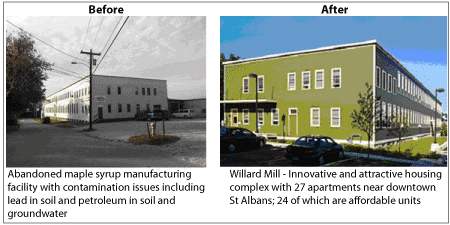 Willard Mill Apartments opened to new residents in 2007 and was fully leased prior to opening. This highly visible downtown project created jobs and incorporated energy efficient and smart growth features. Tubular skylights bring natural light to lower floors and hallways, and automatic sensors judge when hallway lights should be turned on. Renovation of the Leader structure left post-and-beam construction materials exposed in hallways and apartments and natural wood floors and ceilings in place, adding welcomed historic character to apartments. EPA Region 1 highlighted this successful project on its storyboard at the 2006 National Brownfields Conference.
Willard Mill Apartments opened to new residents in 2007 and was fully leased prior to opening. This highly visible downtown project created jobs and incorporated energy efficient and smart growth features. Tubular skylights bring natural light to lower floors and hallways, and automatic sensors judge when hallway lights should be turned on. Renovation of the Leader structure left post-and-beam construction materials exposed in hallways and apartments and natural wood floors and ceilings in place, adding welcomed historic character to apartments. EPA Region 1 highlighted this successful project on its storyboard at the 2006 National Brownfields Conference.
Former Fonda Facility
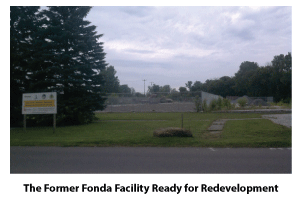 The Former Fonda Container Company/Solo Cup was a manufacturing facility located in downtown St. Albans, currently owned by the City of St. Albans. Environmental site assessments funded by NRPC Brownfields Assessment grants found a variety of contaminants in soil and groundwater including polychlorinated biphenyls (PCBs), semi-volatile organic compounds (SVOCs), metals, chlorinated volatile organic compounds (VOCs), and asbestos-containing building materials. This grant specifically funded a sampling round of on-site and down-gradient groundwater monitoring wells, in addition to sampling of a recovery well installed at a former transformer area. The facility has since been demolished and the site partially remediated, work which was funded in part by a sub-grant from NRPC’s RLF. A Certificate of Completion is imminent from the State. The City is currently part of the Brownfields Economic Revitalization Alliance (BERA), which is pooling together resources to help the site attract a developer.
The Former Fonda Container Company/Solo Cup was a manufacturing facility located in downtown St. Albans, currently owned by the City of St. Albans. Environmental site assessments funded by NRPC Brownfields Assessment grants found a variety of contaminants in soil and groundwater including polychlorinated biphenyls (PCBs), semi-volatile organic compounds (SVOCs), metals, chlorinated volatile organic compounds (VOCs), and asbestos-containing building materials. This grant specifically funded a sampling round of on-site and down-gradient groundwater monitoring wells, in addition to sampling of a recovery well installed at a former transformer area. The facility has since been demolished and the site partially remediated, work which was funded in part by a sub-grant from NRPC’s RLF. A Certificate of Completion is imminent from the State. The City is currently part of the Brownfields Economic Revitalization Alliance (BERA), which is pooling together resources to help the site attract a developer.
Swanton Town Garage
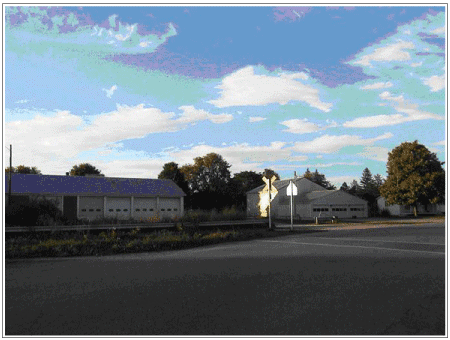 When the State of Vermont conveyed its old highway garage to the Town of Swanton, the Town wanted to investigate whether its existing municipal garage had any environmental issues that would need to be addressed before the property was sold or redeveloped and garage operations were moved to the former state garage. The Swanton Town Garage sits on ¾-acre across from the Swanton Elementary School and adjacent to a proposed bicycle and walking path. Developers have indicated that the site has a high potential for redevelopment as housing. Town Administrator Dick Thompson, who participates on the Brownfields Program Steering Committee, observed “I don’t think that most taxpayers understand the benefits of these types of programs to our municipal budget. Participating in the Brownfields Program saved the Town nearly $28,000 in investigation costs, and allowed us to better understand conditions that might have to be addressed before redevelopment.”
When the State of Vermont conveyed its old highway garage to the Town of Swanton, the Town wanted to investigate whether its existing municipal garage had any environmental issues that would need to be addressed before the property was sold or redeveloped and garage operations were moved to the former state garage. The Swanton Town Garage sits on ¾-acre across from the Swanton Elementary School and adjacent to a proposed bicycle and walking path. Developers have indicated that the site has a high potential for redevelopment as housing. Town Administrator Dick Thompson, who participates on the Brownfields Program Steering Committee, observed “I don’t think that most taxpayers understand the benefits of these types of programs to our municipal budget. Participating in the Brownfields Program saved the Town nearly $28,000 in investigation costs, and allowed us to better understand conditions that might have to be addressed before redevelopment.”
Field of Dreams
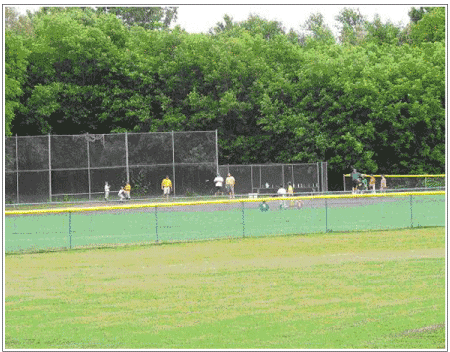 For more than 50 years, children have used the 4-acre Field of Dreams property to play ball. From informal games in a cow field to Little League games on today’s groomed fields, the site has been an integral part of recreation in St. Albans City. Children use the property each year for Little League activities and as a neighborhood park. In 2005, the St. Albans Little League approached the City of St. Albans in hopes of convincing the City to purchase the property, which was currently leased by the City. The League needed to make capital improvements to support recreational activities, but the property owner was hesitant to allow extensive improvements to a leased property. Brownfields program research into the property’s history and use uncovered environmental contamination on adjacent and upstream properties and the potential for this contamination to have spread to the Field of Dreams site. As a result, the VT Department of Environmental Conservation required the CV Properties to test areas of the property to insure recreational uses could continue. Ultimately, CV Properties confirmed low level contamination near Stevens Brook and fenced this portion of the property from use. The fenced section receives floodwater from the Brook and contamination at the Field of Dreams property is suspected to result from soil deposition from an upstream property that is contaminated. VT DEC indicated that recreational use of the property could continue, and parents were assured that use did not pose a hazard to children. In 2008, the St. Albans Little League initiated a $450,000 capital campaign aimed at purchasing the property and making facility improvements.
For more than 50 years, children have used the 4-acre Field of Dreams property to play ball. From informal games in a cow field to Little League games on today’s groomed fields, the site has been an integral part of recreation in St. Albans City. Children use the property each year for Little League activities and as a neighborhood park. In 2005, the St. Albans Little League approached the City of St. Albans in hopes of convincing the City to purchase the property, which was currently leased by the City. The League needed to make capital improvements to support recreational activities, but the property owner was hesitant to allow extensive improvements to a leased property. Brownfields program research into the property’s history and use uncovered environmental contamination on adjacent and upstream properties and the potential for this contamination to have spread to the Field of Dreams site. As a result, the VT Department of Environmental Conservation required the CV Properties to test areas of the property to insure recreational uses could continue. Ultimately, CV Properties confirmed low level contamination near Stevens Brook and fenced this portion of the property from use. The fenced section receives floodwater from the Brook and contamination at the Field of Dreams property is suspected to result from soil deposition from an upstream property that is contaminated. VT DEC indicated that recreational use of the property could continue, and parents were assured that use did not pose a hazard to children. In 2008, the St. Albans Little League initiated a $450,000 capital campaign aimed at purchasing the property and making facility improvements.
Litchfield Property
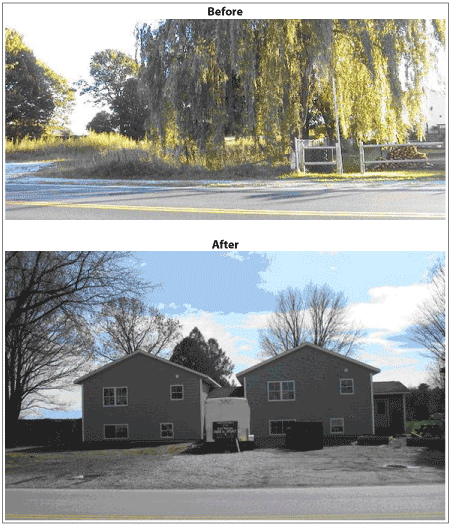 David Litchfield became an unwilling owner of a ½-acre brownfield in Swanton when he bought what he thought would be an investment property at a tax sale. First, he discovered that the rental property was in such poor condition that it had to be demolished. In hopes of cutting his loses, he tried to sell the property – and discovered in the process that it had once operated as a gasoline and service station. “Because I couldn’t prove that the gas tanks had been removed, nobody wanted to buy it,” Litchfield told the Brownfields Steering Committee. The Brownfields Program spent $43,555 of its grant funds to help Litchfield prove that there were no fuel tanks on the property and the site could be redeveloped. The brownfields assessment leveraged $80,000 in private funds and in-kind services when the Green Mountain Chapter of Habitat for Humanity purchased the property in 2006. Habitat developed a duplex residence with the assistance of local businesses and residents and the future homeowners. Residual petroleum contamination in the soil and groundwater will be naturally attenuated, a process by which microbes gradually eat the petroleum and convert it to carbon dioxide. Habitat removed a contaminated dry well and septic system prior to redevelopment. Two families now have a safe and affordable home in the village of Swanton. EPA Region 1 highlighted the project through a BRAG sheet in 2008.
David Litchfield became an unwilling owner of a ½-acre brownfield in Swanton when he bought what he thought would be an investment property at a tax sale. First, he discovered that the rental property was in such poor condition that it had to be demolished. In hopes of cutting his loses, he tried to sell the property – and discovered in the process that it had once operated as a gasoline and service station. “Because I couldn’t prove that the gas tanks had been removed, nobody wanted to buy it,” Litchfield told the Brownfields Steering Committee. The Brownfields Program spent $43,555 of its grant funds to help Litchfield prove that there were no fuel tanks on the property and the site could be redeveloped. The brownfields assessment leveraged $80,000 in private funds and in-kind services when the Green Mountain Chapter of Habitat for Humanity purchased the property in 2006. Habitat developed a duplex residence with the assistance of local businesses and residents and the future homeowners. Residual petroleum contamination in the soil and groundwater will be naturally attenuated, a process by which microbes gradually eat the petroleum and convert it to carbon dioxide. Habitat removed a contaminated dry well and septic system prior to redevelopment. Two families now have a safe and affordable home in the village of Swanton. EPA Region 1 highlighted the project through a BRAG sheet in 2008.
